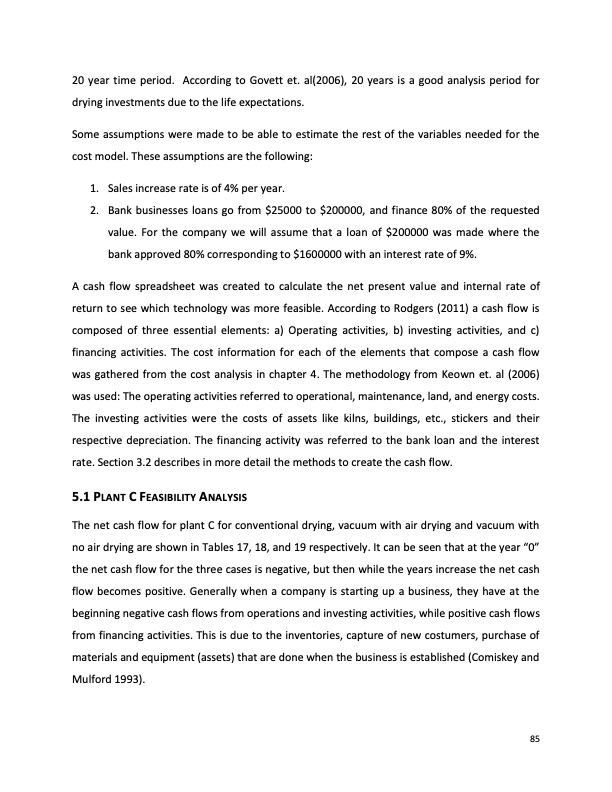
PDF Publication Title:
Text from PDF Page: 095
20 year time period. According to Govett et. al(2006), 20 years is a good analysis period for drying investments due to the life expectations. Some assumptions were made to be able to estimate the rest of the variables needed for the cost model. These assumptions are the following: 1. Sales increase rate is of 4% per year. 2. Bank businesses loans go from $25000 to $200000, and finance 80% of the requested value. For the company we will assume that a loan of $200000 was made where the bank approved 80% corresponding to $1600000 with an interest rate of 9%. A cash flow spreadsheet was created to calculate the net present value and internal rate of return to see which technology was more feasible. According to Rodgers (2011) a cash flow is composed of three essential elements: a) Operating activities, b) investing activities, and c) financing activities. The cost information for each of the elements that compose a cash flow was gathered from the cost analysis in chapter 4. The methodology from Keown et. al (2006) was used: The operating activities referred to operational, maintenance, land, and energy costs. The investing activities were the costs of assets like kilns, buildings, etc., stickers and their respective depreciation. The financing activity was referred to the bank loan and the interest rate. Section 3.2 describes in more detail the methods to create the cash flow. 5.1 PLANT C FEASIBILITY ANALYSIS The net cash flow for plant C for conventional drying, vacuum with air drying and vacuum with no air drying are shown in Tables 17, 18, and 19 respectively. It can be seen that at the year “0” the net cash flow for the three cases is negative, but then while the years increase the net cash flow becomes positive. Generally when a company is starting up a business, they have at the beginning negative cash flows from operations and investing activities, while positive cash flows from financing activities. This is due to the inventories, capture of new costumers, purchase of materials and equipment (assets) that are done when the business is established (Comiskey and Mulford 1993). 85PDF Image | Impact of Vacuum-Drying on Efficiency of Hardwood Products

PDF Search Title:
Impact of Vacuum-Drying on Efficiency of Hardwood ProductsOriginal File Name Searched:
Brenes_Angulo_OM_T_2014.pdfDIY PDF Search: Google It | Yahoo | Bing
5,000 BF Shipping Container Lumber Dry Kiln For Quality Lumber The 5,000 BF container kiln consists of one 40 foot high-cube aluminum shipping container... More Info
Shipping Container Lumber Dry Kilns by Global Energy Global Energy designed and developed the container kiln back in 1991. The purpose is to give access to portable sawmill owners, furniture makers, and small business the value added profit of dry kiln lumber and quality hardwoods... More Info
Vacuum Kiln Conversion Kit for Lumber and Wood Dry Kilns Convert your existing conventional dry kiln into a fast drying vacuum kiln. Similar to vacuum bagging in the boat building and aircraft industry, we have come up with a proprietary process which allows you to build a very simple vacuum kiln at a fraction of the price, and without the intensive conventional metal chamber structure... More Info
Vacuum Pump Cart System for Bagging Clamping Wood Drying and more Vacuum Cart with 2HP Pump and Dual Pistons with multiple multiplex vacuum ports and liquid reservoir... More Info
Vacuum Bagging Basics Vacuum bagging is a method of clamping, which has traditionally been used in the composites industry, but can also be used for vacuum drying materials, including wood products... More Info
| CONTACT TEL: 608-238-6001 Email: greg@globalmicroturbine.com | RSS | AMP |